|
Contemporary use of this phrasing often alludes to engaging in a certain experience with a calm state of attentiveness, guided by intuition rather conscious thought or effort. It is also interpreted as the activity itself allows a practitioner to achieve a calmed state by engaging in the activity. While the Western interpretation of Zen may be more of a mix of Buddhism, Taoism, and Confucianism influences, it’s roots first sprouted in Zen Buddhism in the 5th century CE. Zen Buddhism focuses heavily on the use of meditation to achieve enlightenment and understanding “the meaning of life”. Many tree climbers experience a state of peace and tranquility when they are high in the branches above. Having a calmed state of mind when sitting in the top of a tree lends itself to practicing mindfulness and meditation. Given meditation involves clearing the mind, the climbing process itself can provide a point of focus, resulting in one’s mind letting go of the everyday worries and concerns that plague our thoughts in our daily routine. Therefore, some people see climbing as meditative in its nature. The Path to Enlightenment In their simplest forms, “The Zen of”, Zen Buddhism, and any of the branches or schools of Buddhism are focused on reaching enlightenment; or attaining the full comprehension of the true nature of all things and life itself. The original Buddha put forth that life is filled with struggle & suffering, which occur when we harbor desires, are guided by our ego, or behave in immoral ways. He went on to present a path we can follow to reduce suffering and find ultimate happiness and inner peace. This path is the noble Eightfold Path. Through following the behaviors in the Eightfold Path, one can escape the suffering associated with the human experience. Escape suffering, reach nirvana, become enlightened. Zen Buddhism emphasizes the practice of meditation as being the key to reaching enlightenment, whereas meditation is just one of the 8 steps put forth by the Buddha. The 8 components in the Eightfold Path include having the right:
Upon considering “the Zen of Tree Climbing”, I find a natural how the philosophical principles in the Eightfold Path are manifested in the tree climbing process.  Climbing the Eightfold Path RIGHT VIEW: Having the right view refers to having the understanding that your actions have consequences, which can lead to suffering. Therefore, you should pursue the knowledge that will help you see and understand things as they really are as this will help you steer clear of suffering. If you can picture yourself standing at the base of a tall tree, looking up at the branches high above, it’d likely strike you that climbing the tree could result in injury. Most of us are not as carefree, or oblivious to consequences as we were as kids. Knowing there is risk involved is usually enough reason for many people to not even consider heading up. With a little training and knowledge however, we can learn what we can look for and how to read subtle details to determine if a tree is suitable for climbing. We can also use this knowledge to make determinations on how to climb the tree while minimizing our risks for injury. It also helps to know that there is specialized equipment and how it can be used to climb tall trees and minimize the associated risks with being at-height. I’m sure you don’t need to have climbed a tree to imagine it being far more enjoyable and rewarding if we do so without injuring ourselves. Having the knowledge and understanding of how to determine if a tree is suitable for climbing can help minimize your exposure to risk of injury & suffering.  RIGHT THOUGHTS/INTENTION: When it comes to fostering the right thoughts or having the right intention, we are looking at cultivating healthy thoughts as they determine our state of mind. One of the biggest obstacles and hindrances new climbers encounter is comparing themselves to others. It appears that that some people are inclined to judge themself by comparing to others, yet how someone else is doing has no bearing on how you will do. It makes no difference if he is doing better than you or if she is climbing faster than you, your path is up your rope, not someone else’s. If your thoughts are focused on how other people are doing, especially if those thoughts are envious or negative in nature, you will lose focus of what is most important - your own progress & success. To reach your goal, you will need a positive mindset and your focus should be on your technique and driven by your motivations. Further, it appears to be reflex for some people to start right off the bat saying, “I’m not good at this” or “I can’t do it.” It’s been said, “whether you think you can or think you can’t, you’re exactly right.” That’s the power of thought. Positive thoughts cultivate a healthy mindset. RIGHT SPEECH: Right speech refers to refraining from divisive and abusive speech. Words of praise and encouragement have a positive impact on others who are headed up on their own journey. Such words can lift a person’s spirits and bring them joy. Whereas using words of criticism and judgement have the potential to negatively impact their psyche and performance. Think back to the idea above; how another person is doing has no bearing on whether you achieve success of reaching your goal. We can either use words of positivity or negativity, keeping in mind that your words also impact your mindset. Abusive language towards others will negatively impact your own well-being. Maintaining positive thoughts and verbalizing them has a synergistic and karmic effect on your own state of mind.  RIGHT ACTION: Right action is to refrain from unwholesome & harmful behavior. Instead, behave in accordance with truth and for the goodness of others. During a climb, we are interacting with the tree and other climbers. Given our reliance upon the condition of the tree to keep us safe, common sense tells us to respect the tree and refrain from causing injury or harming the tree for our own sake. Likewise, our actions should not be such that they cause harm to others, whether they are enjoying the area and tree from the ground or in the branches alongside us. This also goes for the animals and organisms that rely on the tree for food and habitat.  RIGHT LIVELIHOOD: Right livelihood refers to avoiding occupations that directly or indirectly harm others, in essence, provide for your needs in a way that is moral and respects all life. Climbing higher takes energy and therefore we often take breaks to catch our breath and rest our muscles. Once we stop on a branch for a breather, we are able to look beyond the branches and leaves that envelop us. Our field of view has expanded far beyond that which we could see from the ground. This elevated perspective lends itself to a broader understanding of where you are in relation to the ground below and where the tree is situated in relation to its surroundings and the community. Viewing the broader picture, we have the opportunity to see how everything interacts and is connected to something beyond just itself. Each individual has influence on everyone else, and it is in your control to be a positive influence on those you interact with and those who are impacted by your actions.  RIGHT EFFORT: Putting forth the right effort means that we should refrain from unwholesome thoughts. At the beginning of a climb, it is common to have a sense of apprehension. If you are overwhelmed by negative thoughts and emotions, you’re probably not going to leave the ground. Once you start your ascent though, your focus turns inward – your body and mind is fully engaged and focused on your climbing technique, the situation and the perceived risks you are putting yourself in, and the wide range of emotions you encounter. Any one of these challenges could become a distraction and a hindrance, and ultimately could have you heading back to the ground. Successfully reaching your goal and having a rewarding experience is very much dependent upon your ability to maintain a positive state of mind by keeping negativity from encroaching. RIGHT MINDFULNESS: The idea of right mindfulness involves actively contemplating sufferings in your body, feelings, and mind. Reaching the top of the tree, your efforts have brought you to your goal. As you sit up there taking it all in, your heart rate decreases. You can reflect on everything you encountered along the way. You are aware of obscure muscles you may have never realized where there. Sitting in the branches high above the ground, those types of thoughts eventually fade and you are able to sit, take in the view, and appreciate being where you are. You have the opportunity to appreciate all of the aspects you encountered along the way, everything around you, and yourself, without judgement. Having a cleared mind and being in this special spot elevated above all else is conducive to letting your mind enter a state of contemplation and mindfulness, where you can gain insight into your true self. Tree climbers refer to the time spent in this state of peace as “tree-time”.  RIGHT CONCENTRATION: Right concentration involves bringing awareness to ways in which you can address hindrances to your clearing of the mind and bring all aspects of the 8-fold path in harmony. Each of them supports and relies upon one another. You encounter a variety of thoughts and emotions during the ascent, from fears and feelings of unease being out of your comfort zone, to self-doubt. You can reflect upon each challenge you faced and how you dealt with them. If your focus remained centered on positive actions, thoughts, and words… …sitting with a cleared mind, you have the opportunity for active assessment in how you might be able to adjust different aspects of your technique and mindset in order to improve and strengthen the impact of your climbing experience or practice. Awakening Your True Nature The tree-time state of mind is calmed and quiet. Being in the moment, brings clarity of mind. Stay up there long enough and even this state of bliss and wonderment might begin to subside. Your physical, mental, and emotional states of well-being are in harmony. All is well, everything is perfect. You have the opportunity to experience total peace of mind and self. With a mind freed from desire and unwholesome thoughts, you can enter a state of perfect equanimity and wakefulness.
Climbing into the treetops can be a life-altering journey, one that might lead you to a state of samadhi and enlightenment. Even if you don’t experience that deeper state, most people walk away feeling a deeper connection to the natural world and quite possibly, insight into their true self.
0 Comments
After spending the past few weeks camping and hiking in various forests of the eastern U.S., I noticed marked differences in my demeanor and state of mind. Even with the sacrifice of physical comfort by sleeping in a tent rather than in our bed, I slept more soundly. I also noticed an improvement in mental clarity. In part this was due to the absence of the demands and distractions often encountered at home and work; but also from the peace that overcame me as I enjoyed the trees, sun, breeze, song birds, and sights in the forests and along the trails. We were immersed in nature. We felt great!  My wife and I spend a fair amount of time outdoors throughout the year. Whether it is taking trips like this, regular walks in the parks and trails near our house, or enjoying time in our backyard gardens, I know my time spent in nature nourishes my soul and has a positive impact on my health and well-being. Your personal experiences may be like mine and you also feel positive impacts from your time in nature. We hear about Nature providing benefits to our health and well-being, but are the claims real or do they just sound plausible? Sounds Good, Can You Prove It As it turns out, there are numerous studies that looked at and measured the impact of spending time in nature. There are also studies that looked at the human health impact when natural areas and trees have been removed from an area, as was the case in several communities who lost an extraordinary number of trees due to the invasive emerald ash borer. Those of us who have been aware of the positive impacts we experience may have been self-medicating by making time spent outdoors a regular part of our weekly routine. Obviously medical professionals need to operate on hard evidence rather than opinion, so thankfully this information has been making its way into the medical field and showing up in doctor’s prescriptions! Easier Said Than Done I am fortunate that my work schedule provides the opportunity for me spend time in nature most days of the week. Even my hobbies of walking, hiking, and gardening draw me outside. Thankfully my wife is able to motivate me to get outside to play, exercise, or simply relax when I have found myself content with sitting on the living room couch. With all the opportunities I have to get outdoors, I still look for assistance and guidance from professionals to help me maintain focus. A few years ago I found a health & wellness coach who has helped in my pursuit of a healthy life-style and other personal goals. With her expertise in health, wellness, and nutrition education & coaching, she has been great to work with and learn from in regard to the role that spending time in nature plays in her clients’ success. Recently she invited me to sit down with her and a colleague to discuss my experiences and our tree climbing programs. I know I need to be physically active and get outdoors, but that doesn’t mean I always have the motivation to move. What Does It Take to Get Me Outside My tips include:
As we discussed during our time together, part of the intent behind our tree climbing experience is provide a unique and exciting way to get outside, move, and connect with Nature. (The appeal of the climb lured her to join me in the tree for an additional segment you'll hear at the end of to the podcast)
With the energizing affect that comes with climbing tall trees, I hope it provides further motivation for participants to make spending time outdoors a regular part of their weekly schedule. 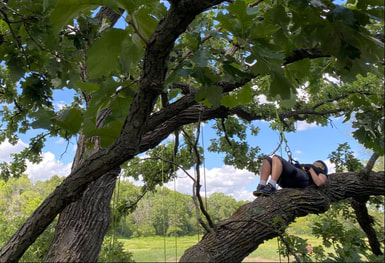 Where do you go to unwind, slow down, find peace? A walk at the end of the day helps to quiet my mind. My wife and I take weekend hikes which help us unwind and enjoy a peaceful morning together. Walking in parks lends itself to providing a calming effect after a busy day. Crossing paths with others is almost a given in these situations, and I enjoy the sense of camaraderie I feel as I nod to others who seem to be enjoying the same experience as me. However, there are times where I wish to be further removed. I like to find places that are accessible but where I may be one of the only people around. These days it is often that I need to hike further distances to get away from the more heavily trafficked areas. I don’t necessarily need to find a completely secluded spot, but it is nice to find a place where I can be alone for at least a short period. When I need further distance, I often find myself in the branches high above. Up there I usually only come across birds and squirrels. I have yet to cross paths with anybody while I’ve been climbing a tree. Energized yet at peace The energizing effects take hold as I leave the ground behind on my way into the branches. Once I reach my destination, be it the top of the tree or one of the many branches to sit on, I can focus my attention inward. The common city noises and chatter from others playing nearby may still be in earshot, but they are softened by the distance. Laying my head back on a branch and gazing into the canopy above, those distractions are gradually drowned out by the rustle of leaves in the breeze. This is when I notice that I have already begun to unwind and calm my mind. Up here I can enjoy the life in the canopy and the peaceful feelings that overcome me.  Taking it all in Sitting alone, looking down, you enjoy a view and perspective most people seldom have. It can feel like you’re floating above the daily grind and able to focus on the simple pleasures in your life. Back on the ground your worries and troubles wait for you. Up here though, those worries cannot reach you. You are free to enjoy your time alone. You can take the time to explore your thoughts and emotions. With your heightened energy level that comes with the location, you are likely to reconnect with yourself in a way that may escape your reach during the demands of your day. That’s how it is for me, which is part of what drives me to provide the opportunity for others to experience tree-time. Climbing tall trees is fun and why we offer the recreational experience. It is also therapeutic, and why I climb on my own or share a branch with a friend. 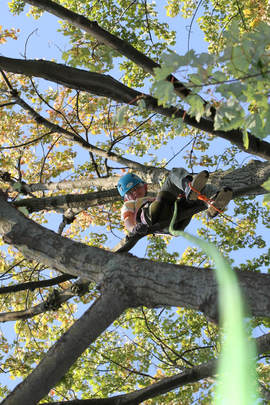 The confidence you have in yourself has a major impact on your level of happiness through life. When I am lacking in confidence as I take on a new task, I find myself immobilized by fear, uncertainty, and feelings of anxiety. My mind says things like, "I can't", "I don't know how", and "I haven't done this before". The view forward is obscured and the task appears overwhelming. Have you experienced this? Have you seen it in your children? Confidence plays an important role in everybody’s life. A person's level of self-confidence is directly related to the level of success they can achieve in pursuit of their life goals. Fortunately, as it is with most skills, we can maintain and build confidence through regular practice. Rock climbing and climbing trees are not only hobbies I enjoy, they provide opportunities for me to build confidence in my abilities. Working through the challenges I face in these hobbies can either build or diminish my level of confidence. Since tree climbing is a hobby I share with others, it provides me the additional perspective of watching others work through their own challenges. In working with many climbers through the years, I have noticed three important steps in building confidence: overcome self-doubt, split a large goal into a series of smaller goals, and focus attention inward. Overcoming Self Doubt "Whether you think you can or think you can't, you are right." Negative self-talk is the first thing that must go. As the case with most challenges, if you are to have any chance at successfully climbing to the top of the tree you will need to overcome self-doubt. This doubt tends to be triggered by fear. Each of us has our own fears to work through. Fear of heights. Fear of embarrassment. Fear of failure. Brand new experiences can be scary. For those facing and working through a fear, self-doubt creates an obstacle. Simply taking the initiative to try something new may be enough to help you overcome your fear. That first step might give you a boost in your confidence. Pair that with a little know-how and you are better able to pursue your goal for the day. My role as a facilitator is to aid you on your journey to reaching your goal. I can show you the technique yet I cannot climb the tree for you. Once you are on rope, my words are all I have to help you. More often than not, they are more than enough if I use them to convey positive thoughts and encouragement. Our fears express themselves in the words we use. This means that the words you use have a profound impact on how well you will perform. "I can't" seems to be the most common and inhibiting phrase I hear people say. These words are typically uttered within one minute of trying to climb; which leads me to believe they are spoken more out of reflex or conditioning. A coach or facilitator can help present a positive environment, but your self-talk often has the biggest impact. In order to move forward, we must stop the negative self-talk. We can replace it with positive words like, "I can do this" and "I am doing it." Speaking and thinking positive words and thoughts instills confidence. Building on a Series of Smaller Goals "What would you attempt to do if you knew you could not fail?" Sometimes our goal is so lofty that we have no idea how to achieve it or even where to begin. In order to reach the goal, we will need to break it down into smaller steps. There are many reasons why this approach leads to success, but I think a primary driver is that it allows us to realize successes at each step. With a small boost in confidence at each step, we are energized and ready to take the next step. With each successive step our confidence continues to grow. When Thomas came to climb with us his first time, his sight was set on climbing to the top of the tree. He came with confidence. As he began to ascend, his focus appeared to be strictly on reaching the top. Focused on that goal, he began to struggle because he tried to skip some of the steps involved in the climbing technique. The sit-stand technique is the foundation of the climbing method. Given his struggle, he naturally resorted to trying alternative methods like pulling with his arms and kicking his legs out. When he realized he was still not getting higher, his frustration began to build and his confidence plummeted. When trying to help a person build confidence, they must be allowed to work on their challenges. Personal growth happens through personal experiences of trial and error. Constantly telling a person how to do something or doing it for them robs them of these invaluable lessons. By having Thomas turn his attention back to the basic steps in the climbing technique, he was able to focus on the fundamentals needed to ascend. The steps necessary to reach his overall goal. With his focus back on using his legs versus his arms, he began to regain some of his confidence. After repeating the process a few times, he realized that he had ascended to 15 feet on his own. In a short period of time, his smaller goal of reaching the first branch was achieved. After a short break to acclimate himself to the height he had climbed (it feels a lot higher when you are looking back down at the ground!), he proceeded to climb higher. Eventually, his ultimate goal was only a few feet away. Thomas' goal of climbing to the top was unachievable until he broke it down into smaller attainable steps. With each success, his confidence grew. With each boost to his confidence, he was prepared to take on the next challenge. Gradually, his ultimate goal came into focus. Do Not Compare Yourself to Others "It doesn't matter what others are doing. It matters what you are doing." Building confidence in yourself has nothing to do with other people. Confidence is understanding and knowing what you are good at or the value you provide. In order to build confidence, you must be focused on yourself and your own experience. When Thomas began to struggle, his frustration was further compounded when he noticed that others were higher than him. He lost confidence when he viewed his slower performance compared to the others as a reflection on his ability to succeed. His ability to climb had absolutely nothing to do with how well the other climbers did. Comparing himself to others only allowed negative self-talk to return and diminish his confidence. Almost like a light switch, when he returned his focus to his own progress, his confidence returned immediately. Hobbies That Build Confidence “The more risks you allow your children to take, the better they learn to look after themselves.” I value activities that challenge and provide me opportunities for growth. Climbing trees for both recreation and work as an arborist has had a tremendous impact on me over the years. These experiences drive my desire to make recreational tree climbing available for others. In doing so, I have seen it have the same impact on those who climb with us each year. From April through October, I am surrounded by people. My weeks are filled with facilitating climbs and teaching classes. One of the most common bits of feedback I receive is in regard to the affect that tree climbing had on the participant's self-confidence; whether it is a parent who has observed it in their child or an adult who has returned to the treetops. The climbing you get to enjoy during our events is not only exciting and fun, it will provide a confidence boost that you can take with you as you pursue new challenges and goals in other areas of your life. With confidence, happiness and success follow. Our Beginning Tree Climbing classes begin in March and public climbs start in April. Until then I encourage you to seek out hobbies and experiences that can help you and your children continue to build confidence until you can return to the trees with us! Name: Captain Tony Species: bur oak Height: 55 ft Trunk Diameter: 3ft 2in Spread of Branches (tip-to-tip): 55 ft Approximate Age: 100-150 yrs It seems every time I visit this tree I am treated to a wonderful encounter. Approaching this tree in the morning provides the opportunity to watch the foggy mist rolling across the lake. The soft wisps have a calming effect on my mood. I often take pause during my morning climb preparation to appreciate the beauty and song of a pair of loons on the water. As the sun begins to rise, I am energized by the rays of light shining through the mist and their wonderful reflections in the branches above.
One particular summer day, I climbed into this wonderful oak to take time for myself. I went up there to enjoy the view across the water and lay back on a branch shaded from the leaves above. Being a rather warm and humid day, a song came into mind; “I went down to Captain Tony’s to get out of the heat.” You may recognize the lyric from a Jimmy Buffett song where he sings of the man and saloon in Key West. For a brief moment, I was back in the Keys heading in for a break from the sun and heat. It was at that moment this tree became known to me as, Captain Tony. Trees are living beings and I am often moved to formally recognize certain individuals by name. The name is not so much a tribute to a person or place; but, to the emotion, feelings and reflections I experience when in the presence of this tree. 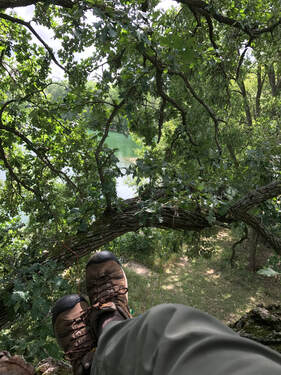 With over 50 species of oak in North America, bur oaks are known for their impressive branch spread and trunk diameter. Living in Wisconsin provides us the opportunity to appreciate large bur oaks on a regular basis. The largest bur oaks have branches reaching 100 feet across and trunks close to 9 feet wide! Wisconsin’s largest known bur oak has a trunk over 7 feet in diameter and is located in Waukesha County. Walking around Fox Brook Park you are able to appreciate a number of large and majestic bur oaks. Each has their own presence about them and worthy of taking time out of my day to stop and appreciate. Captain Tony is a little more modest in size yet extra special as I have spent time in his branches. Those of you who have climbed Captain Tony may know what I am talking about as you have your own memories and connection to the tree. This tree touches people in different ways, so I am excited to offer a variety of experiences this year. Should you like us to introduce you, we will visit the tree on numerous occasions in the year ahead: Adult Tree-Time, Rec Climbs, Open Climbs, Girl Scout Adventure Climbs. Our climbing club will also have the opportunity to explore the canopy and enjoy hammocking! EVERYONE needs playtime! Play is an essential part of life. Children get it. Some adults have forgotten. Play is vital for the enjoyment of life as well as social, emotional, intellectual and physical development. Picture yourself playing within this week’s video. Come play with us! Register for a climb today and come experience it for yourself!
I spend time with trees by sitting beneath them or hiking through the forest. Of course, I also like to climb them. I’ve enjoyed climbing trees for as long as I can remember. The oak in our front yard in Miami was one of my favorite climbing trees growing up. It was a rite of passage when I could finally jump high enough to grab hold of the lowest limb and pull myself into the tree without any assistance from my older brothers or standing on my bike. “I used to climb trees.” I hear this quite often when I tell people what I do. After sharing enjoyable memories, some people follow up with, “it was so much fun.” Therefore, it begs the question, “Why did you stop?”
When most people think of tree climbing, they tend to envision free-climbing, using hands and feet to climb branches without the aid or safety of rope. Technical tree climbing utilizes ropes and saddles to climb trees. Each style of climbing offers a variety of benefits and experiences for the climber. Free Climbing Growing up in Puerto Rico and Florida, we climbed numerous rubber trees (Ficus elastica). Our hands coated in sticky sap enabled us grip and swing from their aerial roots like Tarzan! We could shinny up the schefflera trees and climb onto the roof of our house. We climbed and picked countless mangos, loquats and tangerines from trees around the neighborhood, bringing them home to feast upon them at the top of our favorite climbing tree. Those days of free-climbing involved smaller and even some medium sized trees. For the most part, climbing a tree in this manner requires that the tree have enough branches to provide hand and footholds. Free-climbing small trees calls upon our primal instincts as we explore these living jungle gyms. Free-climbing a tree without the use of rope, you are exposed to a higher risk of falling. I think this is the primary reason people are discouraged or even forbidden to climb trees, even though playgrounds are filled with structures for climbing and enabling children to get off the ground. The simple act of climbing develops a person’s hand-eye coordination and motor skills. Each step of the way while tree climbing, you are determining where to place your hands and feet to gain vertical height. Trees do not have a standard arrangement of limbs or spacing between branches like a fabricated jungle gym. Planning a few steps ahead is a necessity as the path is not a straight line up. Returning to the ground can be even more challenging. An adrenaline rush and flood of emotions accompanies this type of play. During our time in the tree, we are also rewarded with releases of “feel good” hormones like endorphins, dopamine and serotonin. You don’t need to know what these are because you can feel their effects even if you don’t know their names. I love reading the research about such benefits today as that helps fuel my passion for providing an incredible experience for people to spend time in the trees. Back then, all I cared about was that climbing trees was a fun and exciting way to spend my day. 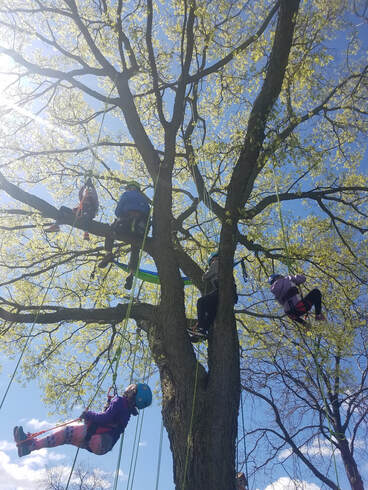 Technical Tree Climbing When we moved to St. Louis, we had a sugar maple that could be climbed, but it wasn’t nearly as much fun as my previous climbing tree. Aside from the maple, we had oaks, hickories, and elms that were too tall to climb since the lowest branches were about 20’ high. If you have the desire to climb into taller, larger, older trees, you are out of luck if they do not have low and small enough branches for climbing. Thankfully, ropes, saddles and specialized techniques allow us to climb into these magnificent trees. Climbing rope requires a unique set of motor skills and spatial awareness in addition to those skills we developed as free-climbers. It also requires the use of muscles you may not have known were there! Sitting back in your saddle and letting the tree and rope support your weight has an energizing effect. Once you climb into the crown of the tree and can play in the branches, you are continuously transferring your weight and sense of security between sitting in rope and being supported by a branch. The transition back and forth brings new challenges. This is part of what makes technical tree climbing a lot of fun and different from free-climbing. Once you begin to master the balance between using branches and using rope, you are better able to climb and explore the tree at will. You are able to enjoy the freedom of spending time in the branches without having to hold on. Another key difference is that, with rope, you can climb much higher. Some of the taller trees in Wisconsin allow us to ascend over 100 feet above the ground. The tallest trees in the world allow climbers to reach heights over 350 feet. While these heights sound impressive, the reality is that most people are challenged and impacted by reaching heights between 10 and 35 feet. The trees we climb around Wisconsin are perfect as they allow us to play in this realm. For those who like pushing the limits, I often include a few ropes that reach 40-50 feet during my climbs. In private excursions and guided climbs, we go even higher. In the end, the height each of us is most comfortable at will vary greatly. Using rope and saddle enables you to progressively challenge yourself to reaching new heights. Climb Trees
As a kid, I free-climbed trees because I didn’t know any other way. These days I climb using rope and saddle. Thanks to this hobby, I am able to explore amazing trees and chase views that few people will ever get to enjoy. I doubt my parents ever stopped to ponder the emotional and cognitive benefits I was receiving during my time in the trees. They knew it was important for kids to play outside because they could see the differences in my demeanor between those days and the ones I spent mostly inside in front of the tv and playing video games. Today, I notice differences in myself during and following my time in the trees. When I reflect back on my childhood, I am grateful my parents allowed me to climb trees. As long as you take into consideration that the tree you are climbing is a living being and do what you can to minimize your impact on the tree, I encourage you to get out and enjoy the trees. Take your children and loved ones with you. *Fine print: prior to entering a tree, I perform a thorough inspection to assess its health and structural integrity. There are a number of issues and conditions that can make a tree unfit for climbing. If you are unsure of the condition of your trees, please contact an ISA Certified Arborist and have them assess your tree (yes, even the small ones). If you are interested in climbing tall and mature trees, give me a call! I take a lot of pictures during our climbs. The experience is different for each climber, each person benefiting from it in their own way. Describing the different benefits that come from climbing trees can be difficult. But you can see it for yourself in this week’s video. Register for a climb today and come experience it for yourself! Warning: Playing outside can cause bruised arms, scraped knees, stubbed toes, dirty hands, stained clothing, muddy shoes. You will get wet when it rains, cold when temperatures are low, and hurt when you fall. Some people may require band-aids, ice packs, or loving arms to hold them as they cry. Life is one huge adventure for those who aren’t afraid of getting dirty. There are many places to explore, limitations to discover, and life lessons to learn. If we don’t learn them as children, then our road ahead will be hampered. Do you ever look back on your own childhood and feel grateful for the experiences you had and the lessons you learned when you were younger? You did not become the strong person you are today in spite of the challenges you faced, but rather because of them. I found it humorous, if not annoying, when my father would say, “when I was your age, I had to walk 5 miles to school.” My typical response was to roll my eyes, as that was what all old people said. These days I catch myself thinking and saying some of the same things! In reality, every generation thinks the next generation has it easier and aren’t as capable of dealing with hardships as they were. This has been going on for 2,000 years! (Check out this article: Proof That People Have Always Complained About Young Adults The more I consider the implications related this line of thinking, I think what we are really saying is that we are grateful for the challenges we had to face when we were younger and the leaders who provided encouragement and opportunities for me to do things for myself. This includes parents, teachers, and coaches. Facing Challenges I typically set up a number of ropes during a climbing event, each presenting different challenges for the climber. If your climbing rope is away from branches and hangs unimpeded from the top anchor point to the ground, your primary challenge will be dealing with your height above the ground and associated fears. By placing ropes so they hang near branches, you will face the challenge of maneuvering past the branch. The closer the rope is to the branch, the more difficult it is to climb around it. At one of our climbs this past summer, a young climber was climbing one of the more challenging rope routes of the day. The rope the young climber was on hung against a branch. With her weight on the rope, the rope rubbed snuggly against the branch above her head. Since her ultimate goal was to reach the top of the rope, well above this lower branch, she was going to have to get herself around it. Since the climbing knot slides up the rope that ran against the branch, she would need to pull the rope away from the branch in order to slide the knot around and above the branch. Until the knot was pulled away from the branch, there was a pinch point. In trying to get past the branch, she got her hand pinched between the rope and the branch. Ouch! She tried again. After a few attempts and just as many scratches on her fingers, she was beginning to get frustrated. After providing her with a few calming and encouraging words, she took a moment to analyze the challenge. Looking back up at the knot and impeding branch, she considered an alternative strategy that could potentially get her around the branch. Taking time to reassess the situation trying out an alternative technique was all she needed to figure out how she could overcome what seemed to be an insurmountable challenge. While her goal that day was to reach the top of that rope, the value of the climb happened along the way, and required a few scraped knuckles. She enjoyed her view of at the top, but she felt empowered and more self-confident because she was able to work past that lower branch. I am confident that the lesson she learned in the tree that day will stick with her as she faces challenges in school and work in her years ahead. Even more important, I hope she has the opportunity to encounter similar challenges often, for that is what will make her stronger and better prepared for what lays ahead. Learning On Our Own Often times adults are tempted to swoop in and offer up a solution as soon as we see a young person encountering an obstacle. With our life experience, I could picture the forthcoming pinch point for the young climber trying to get past the branch. In trying to help out, I could have interrupted her mental engagement and told her precisely how to avoid the obstacle. In doing so, I would have robbed her of the learning opportunity. However, we can only learn so much from listening or watching adults and leaders. We must do it on our own. Parents, teachers, and coaches are constantly balancing how much to help and how much to step back. Our role is to offer up and pass along knowledge to our children or students. It is up to them to take these tools and apply them to their own experiences. In order to teach a person how to climb up our ropes, our responsibility is to explain and demonstrate the knots and technique used to ascend. Then we need to step back and allow them to try on their own. They will make mistakes. They will move and process slower than us. This is the learning process which involves and extraordinary amount of activity going on inside the mind and body of the climber. The length of time required varies significantly between people and is greatly influenced by previous challenges they have faced and gained wisdom from. Should they make a mistake along the way, I have 2 basic options: correct them immediately or allow them to proceed. Ramifications of Rescuing If I jump in right away and correct them, then the lesson I am likely teaching them is that they can rely on me to help them through a struggle. They will eventually pick up the technique, but it usually takes much longer as they are not having to work through the steps on their own. Even if they want to figure it out by themselves, their mental process is derailed the moment I give them the answer. One issue with this approach is that I begin to anticipate when the climber is likely to face a struggle. Worse yet, I am then tempted to offer up the solution even before they are aware there is a challenge. Can you see how catastrophic this approach can be? We can deprive the climber of the opportunity to process and problem-solve because the solution is being provided to them before their mind even encounters the struggle. Freedom To Figure It Out
In contrast, if I allow them to proceed, they will soon figure out they missed a step. While it may look to bystanders that they are sitting there not knowing what to do, they are actually quite busy inside their head. They are processing through the information they gathered during my presentation and demonstration, then trying to figure out how to move their body in order to replicate the technique. They will figure it out. When they do, that is the moment they will have not only learned the process, but also became self-reliant, problem-solved, gained confidence, felt satisfaction, and built positive self-image. It is a challenge to determine the appropriate level of guidance to provide each climber. I strive to provide positive experiences as I do not like to see climbers become frustrated. The point of frustration triggers responses that are detrimental to a person’s learning process and obviously the enjoyment of the activity. Of course, there is a point at which we need to intervene in some manner. I just try to keep in mind that my ultimate goal is to help them learn how to do it on their own, not micromanage them to the top of the rope. It is fun to get to the top. It is rewarding if you do it on your own. Free play Bumps and bruises happen in all kinds of activities. They are part of the learning process. Not only should we not forget this, we should facilitate opportunities for girls and boys to face physical and mental challenges even if that exposes them to scrapes and scratches. With most anything we do, there are dangers involved that need to be addressed for safety. Once we’ve been able to set the parameters that help minimize the associated risks of severe injury, we should then encourage and allow children to have the opportunity to play freely. I am thankful for the knowledge my parents, teachers, and coaches provided me. I am even more grateful that they allowed me time for free play in order to practice, play, and work through the ways in which I could apply that knowledge. Bumps and bruises are often signs of growth and a lesson learned. Each scrape encountered plays an important role in developing creativity, self-confidence, problem-solving skills, and a positive self-image. Let’s not deprive kids these days of these important opportunities to grow! Screen-time. It seems like we cannot avoid it. Growing up, screen-time was the television. For me that meant MTV, Discovery Channel, sitcoms or playing Atari. Today, screen-time also comes from our phones, tablets, watches, pc’s, laptops. At work, at home, in the car, in restaurants and bars, or even while we sit on a park bench. While I it can be difficult to truly grasp the numerous impacts screen-time has on humans, I recently had an experience that opened my eyes to the conditioning affect I have subjected myself to. For some people, online interaction is the equivalent of the in-person social interactions I am drawn to. When I consider the time I spend online, a fair percentage of it is with social media platforms, news feeds and email inbox. I engage with each of these in a similar fashion, scrolling through a never-ending feed of digital stimulation. Within a fraction of a second, I make a decision for the next course of action. If the item requires a relatively short amount of time for contemplation or consideration, like a picture, I can appreciate it for a few seconds before my thumb intuitively flips on to the next item. If the item holds some value or interest requiring more in-depth engagement, I might give it a minute, but no more. In many cases, the item gets flagged, saved or added to my list for later action. I believe this overabundance of information and stimulation is part of what makes our digital devices so addictive. As soon as I pick up my phone it’s as if I enter a trance where I scroll continuously until one item grabs my attention enough for me to take pause. While I may think I am learning or absorbing the information I come across, I question how much I retain in this state of mind as I cannot process completely before I am on to the next stimuli. This became uncomfortably apparent to me recently. Back in the Analog World One of my weekly goals is to spend one morning dedicated to reading articles, journals and magazines I have collected in my “future reading” pile. This stack of readings and bookmarks include the items from my digital binges, articles I had flagged for later, and notes I take from books I am reading. I was at the coffeeshop one of these mornings with the sole purpose of taking time to read through a small stack of professional journals and research articles that I had set aside. I had already thumbed through the journals and knew there were specific articles that I wanted to give more attention to. I settled in to enjoy quiet time with my readings over a cup of coffee. I began paging through until I came upon the first article of interest. Being somewhat technical in nature, it captured my undivided attention. That article had a lot of great information, and there were plenty more to go. Before long I reached the end of my stack. Looking down at my stack of journals, I had to laugh. Somewhere along the way I stopped reading articles and ended up skimming through the pages and dog-earing the interesting articles for future reading. What was I doing? I was there to read! It’s as if I am on a constant search for new information and answers to my questions, yet not taking the time to digest and process the information beyond face value. When I thought it through, I realized that I had unknowingly returned to my habit of mindless scrolling. My digital reflex had jumped into my analog world. Digital Fast It may seem easy to explain it away with the notion we hear in regard to shortening attention spans, but I doubt it is that simple. Do kids-these-days have shorter attention spans? Has my attention span been shortened in the digital age? I never pursued the field of psychology beyond a handful of introductory courses in college so I may date myself; but, every time I heard a ding on my phone or laptop, I pictured myself as one of Pavlov’s dogs. With each interruption no matter how brief, it typically results in at least a 10 to 15-minute disruption in my day as it takes that long to fully reengage my mind with the task at hand. Talk about a drain on productivity. It didn’t take too long for me to shut off notifications on my devices! I believe that maintaining ready access to social media, news feeds, and e-mail are a powerful distraction and hindrance to engagement with work, play, family and friends. How well do you stay in conversation with your spouse when out to dinner at a restaurant with 15 screens or your phone on the table? This leaves me wondering if attention spans are truly decreasing to a significant level, or how much of this has to do with distraction and conditioning? Move Forward by Leaving It Behind
It takes me long enough to sort through my thoughts and write an article. As I sit here at my laptop I know one thing is for sure; I’d be here all day if I did not have my email closed and phone in my bag. Removing these distractions appears to have a positive effect on my attention span. Keeping my phone in my bag or otherwise out of reach also goes a long way to breaking my sub-conscious habit of picking it up for no apparent reason. Picking it up of course being the trigger to my fingers’ conditioned response of bringing it back to life, sending me tumbling uncontrolled down the rabbit hole. Moderating screen time improves my work product and returns tremendous benefits for me psychologically and emotionally. Digital fasting helps me regain perspective and control of where I focus my attention. One of the aspects I enjoy about taking people into the trees is that everyone engages in the moment. Phones are set down, eyes look up to the branches above and the excitement builds. Being a unique and adventurous experience, it captures participants’ attention the moment they walk up to the tree. Some parents and teachers have wished me luck with their child or student, alluding to their short attention span or the idea that all they like to do is play on their phone. They assume I will have a hard time keeping their interest for two hours without digital stimulation. In reality, there are some climbers who wish to take their phone with them into the tree so they can get some pictures. Most do not. It is common for those who do ask to forget to even pull out their phone while they are climbing! Engaging in the activities you enjoy is great for keeping your attention in focus. Climbing requires some attention on the task at hand. During a climb, everyone needs to take a break. This is when you are able to sit in the saddle, take in the view, catch your breath, and breathe in the moment. You are present in the moment, processing the experience and your emotions. I find peace and a calm mind in activities like tree-time. I find the same when I disconnect. |
AuthorAs a G.O.T.C. Recognized Master Instructor & Facilitator, I.S.A. Board Certified Master Arborist, and T.C.I.A. Certified Treecare Safety Professional, Curt has spent over 30 years dedicated to the study and care of trees. Categories
All
Archives
May 2024
|
|
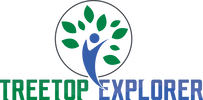




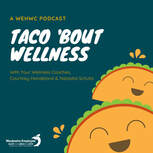

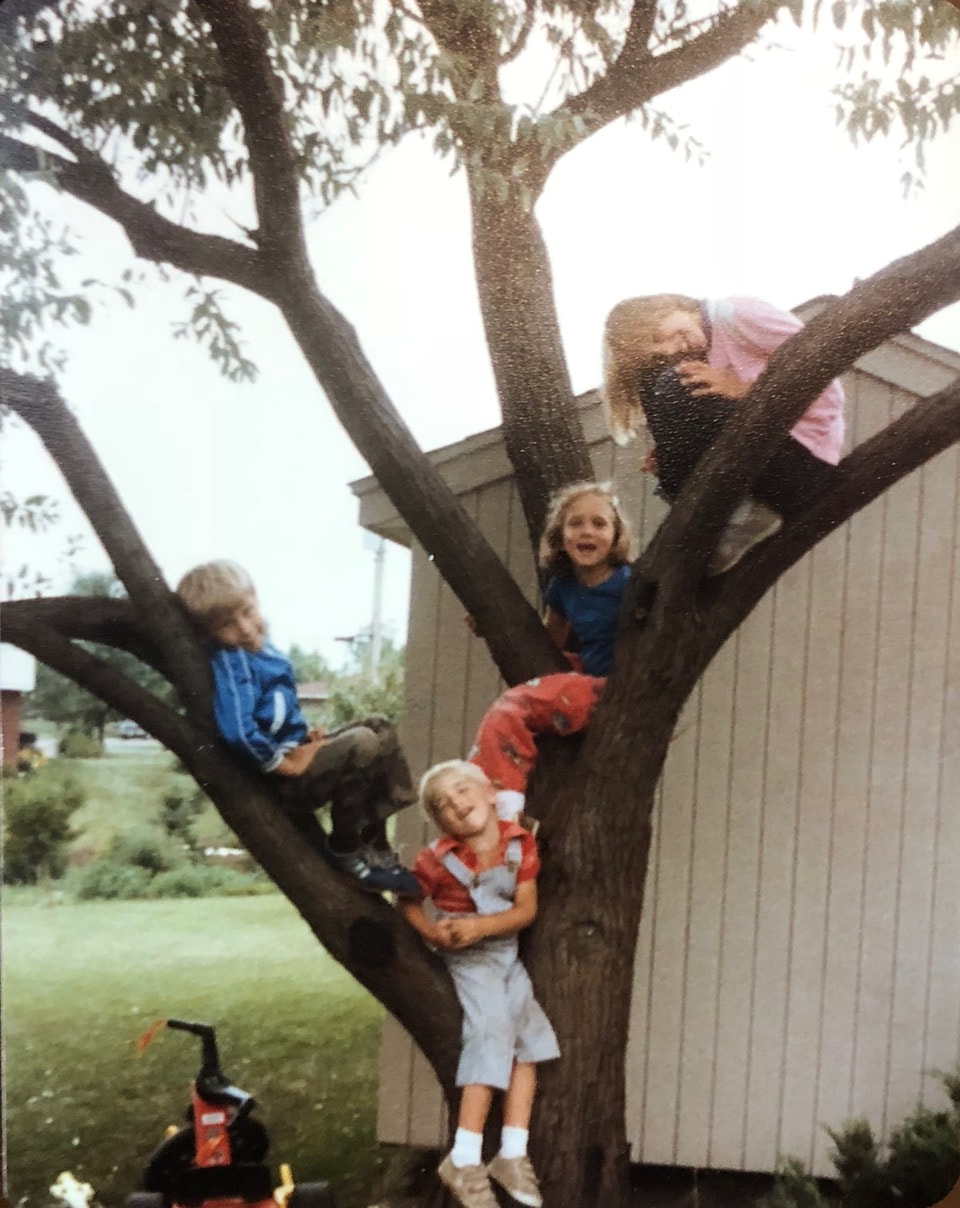

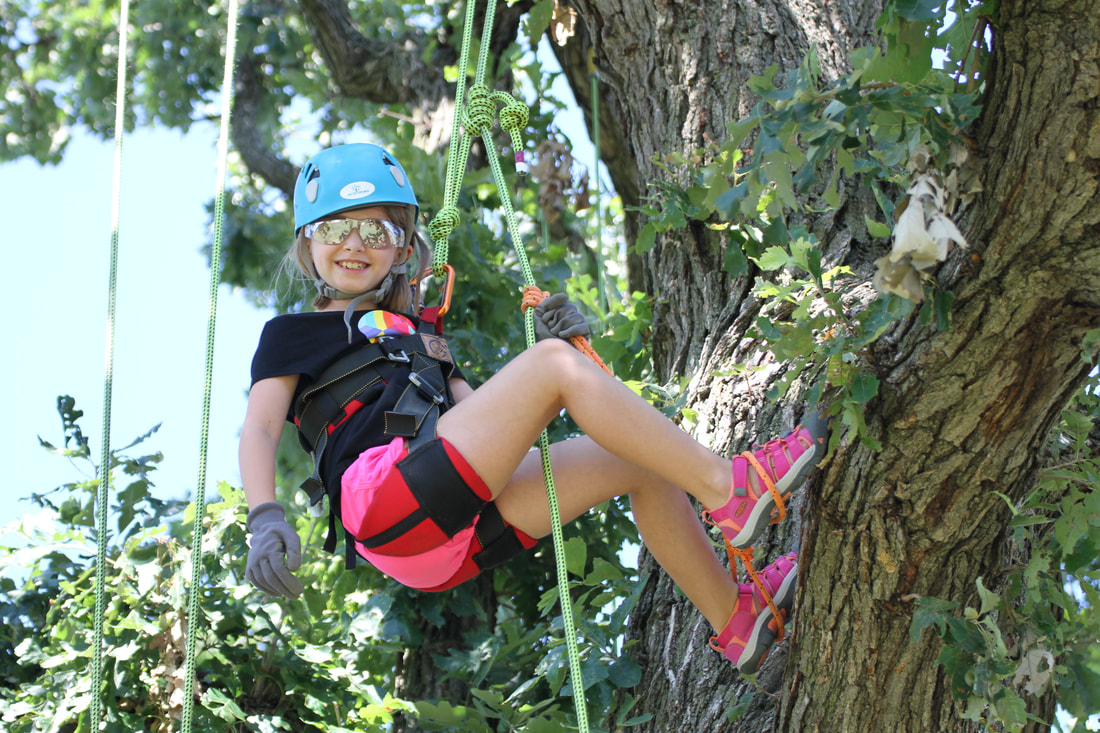

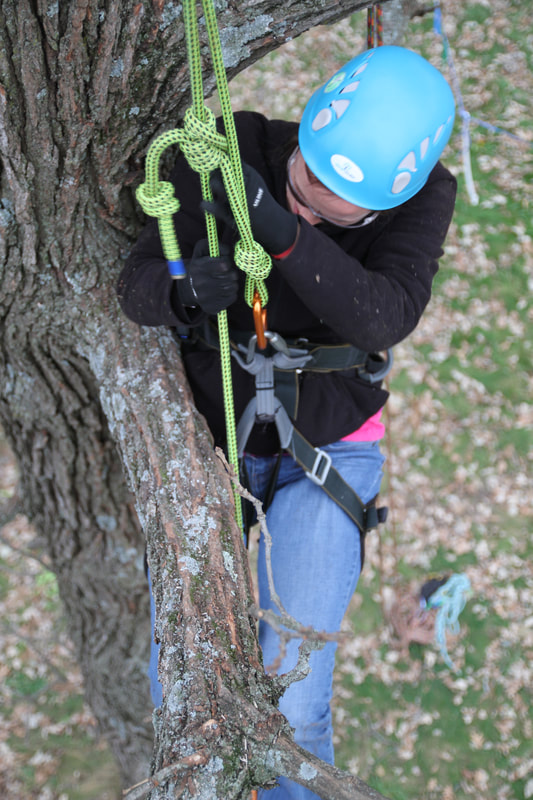
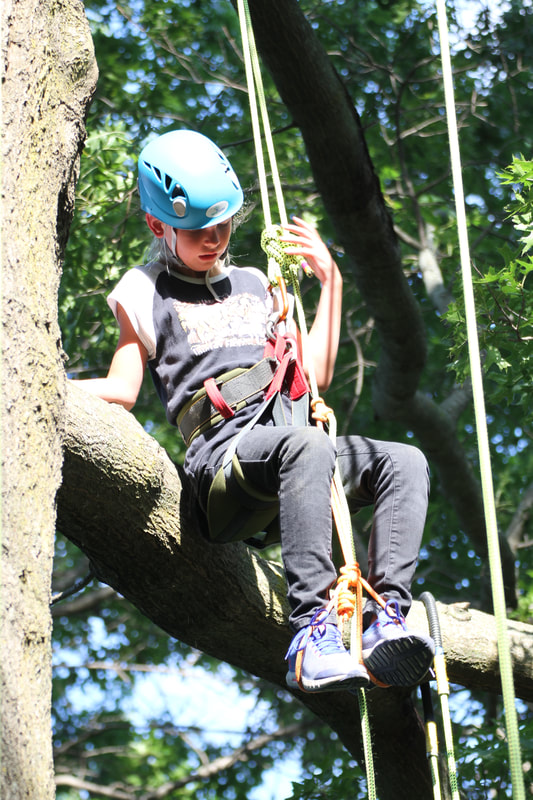
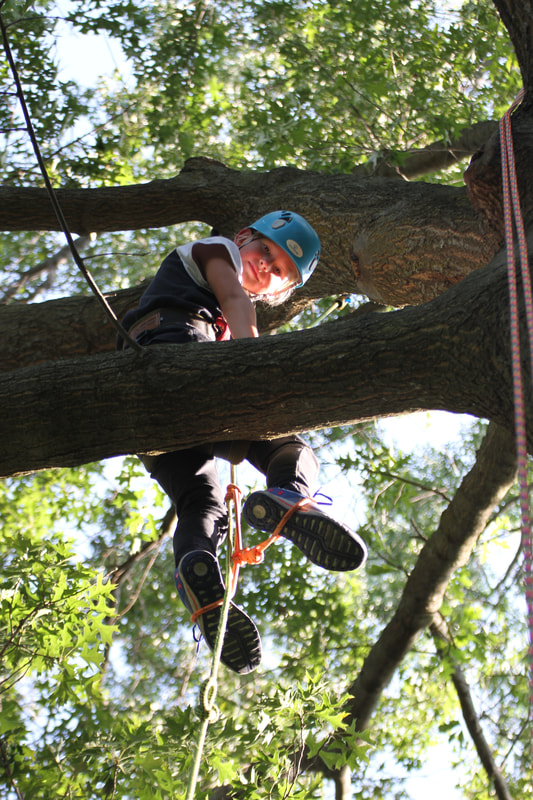

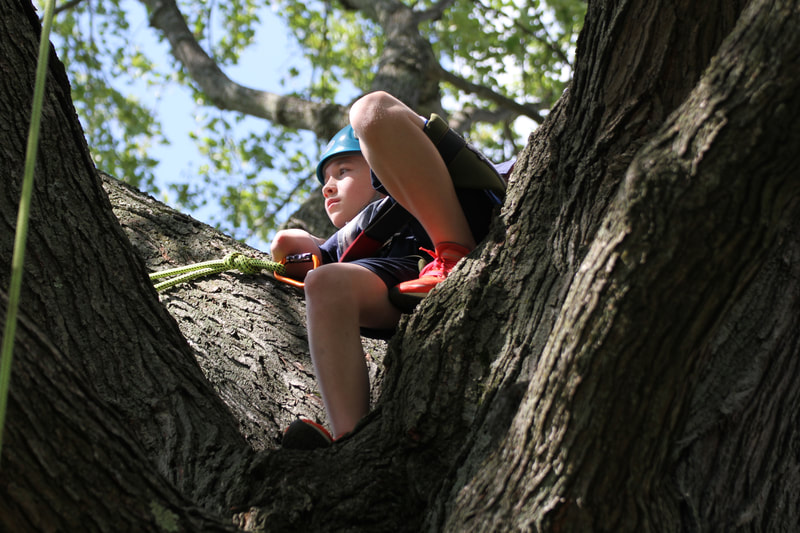
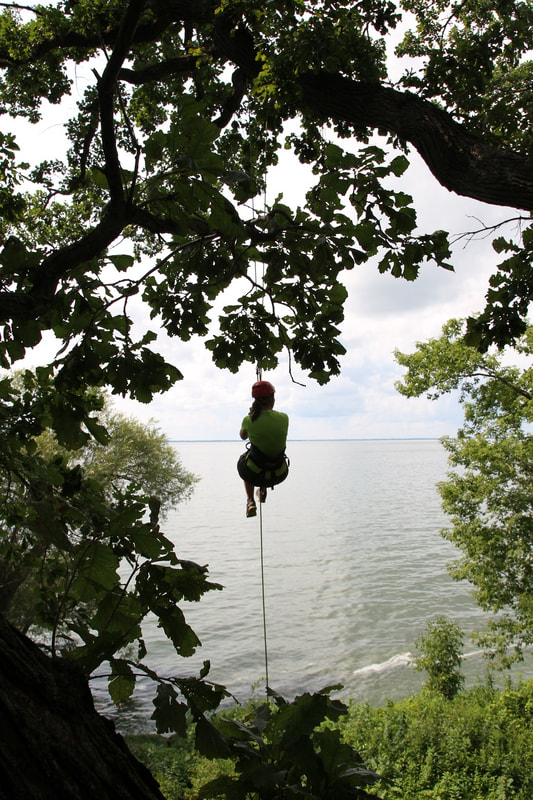

 RSS Feed
RSS Feed
